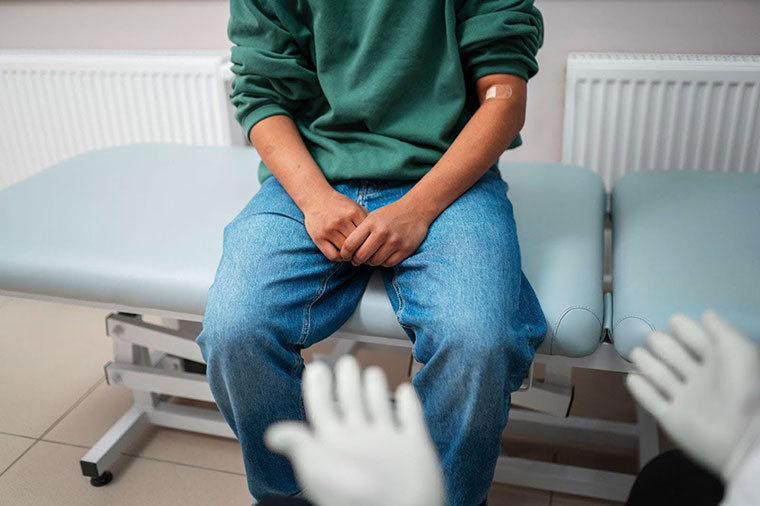High Rate Of Urinary Incontinence In Young People Receiving Home Care

Urinary incontinence (UI) is often seen as an issue that mainly affects older adults, but this isn’t the full picture. In fact, it’s a growing concern for younger men as well, with many under 50 experiencing UI. While childhood and older age are the two main peaks for UI, it’s increasingly being recognized in younger individuals, leading to the need for home care services. Studies show that this condition is more common than you might think, and it can be just as impactful on young men’s daily lives as it is on older adults.
Introduction: Why We Need to Talk About This
This article focuses on the challenges that men, particularly those under 50, face with urinary incontinence, backed by real research. One study highlights that up to 45% of patients under 50 report symptoms, and another confirms the link between UI and neurological disorders, which can affect young men in particular.
It’s important to understand that UI is not just a "normal" part of aging; it’s a manageable condition. You are not alone in this, and with the right support, treatments, and lifestyle changes, it’s possible to regain control and continue living your life without the constant worry of incontinence.
Understanding Urinary Incontinence in Young Men
This condition can arise from various causes, including neurological issues, injuries, or even congenital conditions.
There are a few different types of UI that men might experience:
- Urge Incontinence: This is when a strong, sudden urge to urinate hits, but you can't make it to the bathroom in time.
- Stress Incontinence: This happens when pressure on your bladder—like sneezing, coughing, or laughing—causes urine leakage.
- Overflow Incontinence: In this case, your bladder doesn't empty completely, leading to dribbling or leakage.
- Functional Incontinence: This occurs when physical or mental challenges prevent you from getting to the bathroom in time.
- Mixed Incontinence: This is when a combination of urge and stress incontinence occurs.
For younger men, conditions like neurological disorders (Parkinson’s, stroke, multiple sclerosis), trauma, or birth defects such as myelomeningoceles can interfere with bladder control. Dealing with UI at a young age can have a real impact on your quality of life, affecting everything from your physical health to your emotional well-being. It’s important to recognize that incontinence isn’t just something that happens to older adults, and it’s definitely something you don’t have to face alone.
What the Research Says: Home Care and Incontinence
Urinary incontinence (UI) affects more people than we often realize, including younger individuals, though it’s often overlooked or underreported. A recent study highlighted that 31% of young people receiving home care had UI, which is a significant proportion. This is particularly concerning because many of these individuals are dealing with disabilities or medical conditions, making UI even more challenging.
Among men, those receiving home care for chronic conditions or disabilities are at an even higher risk of experiencing incontinence. This highlights that factors such as mobility issues, neurological conditions, and the need for ongoing medical care can increase the likelihood of developing UI.
Interestingly, UI in younger individuals is often underreported. Many people, especially younger men, tend to ignore or hide this issue due to embarrassment or a lack of understanding of the problem. This underreporting can delay treatment and make it harder to track the true prevalence of UI in this group.
There is also a strong link between mobility problems and UI. Men with limited mobility are more likely to experience functional incontinence, which happens when a person physically cannot reach the bathroom in time. Medications and physical disabilities can further complicate this, making it harder for individuals to manage their symptoms. In some cases, incontinence becomes a long-term problem, with many experiencing it for six months or more.
These findings underline the importance of recognizing UI in younger patients and addressing it promptly to improve their quality of life and overall well-being.

The Emotional and Social Impact
Urinary incontinence (UI) can have profound emotional and social effects, often leading to feelings of shame, embarrassment, and isolation. Many individuals struggle to cope with the social stigma associated with incontinence, feeling vulnerable in situations that others may take for granted, like going out with friends, dating, or attending work events.
Incontinence can take a toll on confidence, affecting relationships, work, and daily routines. For some, the constant worry about leakage or the need for frequent bathroom trips can reduce participation in social activities and cause feelings of depression and loneliness. A study found that men, in particular, report more frustration and shame related to UI than women, even when the severity of the condition is less. This emotional burden can make it harder for men to seek help or open up about their struggles, potentially exacerbating the psychological impact.
For Children:
Incontinence in children can also have a significant emotional impact. Children often feel embarrassed about accidents, especially as they get older, leading to shame and social withdrawal. The fear of being teased by peers or excluded from activities can cause anxiety and hinder their social development. It's crucial for parents and caregivers to reassure children that incontinence is not their fault and that they deserve the support needed to manage the condition.
For Young Men:
In young men, incontinence can lead to a heightened sense of frustration and embarrassment, especially as they navigate dating and career-building. The fear of leakage during work meetings or while interacting with potential partners can hinder confidence. It’s important for young men to know that seeking treatment for incontinence is a proactive step toward improving their quality of life and regaining a sense of normalcy in social and professional situations.

Practical Solutions and Management at Home
Urinary incontinence (UI) can be a challenging condition, but it's important for men to know that solutions exist, and seeking help early is crucial. Speaking with a doctor or home care provider can guide you toward the most effective treatments and significantly improve quality of life.
One key approach is pelvic floor exercises (Kegels), which help strengthen muscles that control urination. Regular practice can improve bladder control over time.
Scheduled voiding or bladder training is another helpful strategy. This involves setting regular times to use the restroom, even if you don’t feel the urge to go. Over time, this helps your bladder adapt to a more predictable schedule and reduces accidents.
Medications like anticholinergics or mirabegron can be prescribed to help control bladder function. In simple terms, these medications reduce overactive bladder contractions, providing relief for those with frequent urges.
High-quality absorbent products, such as pads or briefs, offer dignity, comfort, and skin protection. It's essential to choose products that are suitable for your needs, as they help manage leaks discreetly and avoid skin irritation.
For individuals with mobility issues, external male catheters or wraps can be great options. These are designed to provide a more secure and comfortable solution for managing incontinence. If you or someone you know struggles with this, consider products like QuickChange Wrap, which offer convenience and skin protection.
Hygiene plays a critical role in managing incontinence. It's essential to keep the area clean to prevent skin damage or infections. Regular washing and proper drying can help maintain skin health.
Caregivers also play an essential role in supporting men with incontinence. Their help should always be provided with respect, privacy, and understanding. Offering support in managing daily routines can make a significant difference in preserving dignity and independence.
Moving Forward: You're Not Alone
Incontinence is something many young men experience, especially those receiving home care, but it's not often talked about. It's important to remember that you're not alone in facing this challenge. Many men go through similar struggles, and it's okay to reach out for help.
Joining peer support groups or online forums can be a great way to connect with others who understand your situation. These groups offer a space to share experiences, find advice, and gain encouragement from people who truly get what you're going through.
The main point is that incontinence in younger men is not only common but also manageable. With the right treatment and support, it doesn't have to control your life. By taking the first step to talk about it and seek care, you can take charge of your health and move forward with confidence.
For those seeking support, we invite you to purchase a 10 Count Trial Pack here or request a professional-use sample pack for healthcare institutions here.
References:
-
Combs, A. J., Van Batavia, J. P., Chan, J., & Glassberg, K. I. (2013). Dysfunctional elimination syndromes--how closely linked are constipation and encopresis with specific lower urinary tract conditions? Journal of Urology, 190(3), 1015–1020. https://doi.org/10.1016/j.juro.2013.03.111
-
Fultz, N. H., & Herzog, A. R. (2001). Self-reported social and emotional impact of urinary incontinence. Journal of the American Geriatrics Society, 49(12), 1730–1737. https://doi.org/10.1046/j.1532-5415.2001.49179.x
-
Heesakkers, J., Farag, F., Bauer, R. M., Sandhu, J., De Ridder, D., & Stenzl, A. (2017). Pathophysiology and contributing factors in postprostatectomy incontinence: A review. European Urology, 71(6), 936–944. https://doi.org/10.1016/j.eururo.2016.09.031
-
Huang, Y. C., & Chang, K. V. (2023, May 1). Kegel Exercises. In StatPearls [Internet]. StatPearls Publishing. Available from: https://www.ncbi.nlm.nih.gov/books/NBK559095/
-
Khullar, V., Amarenco, G., Angulo, J. C., Cambronero, J., Høye, K., Milsom, I., Radziszewski, P., Rechberger, T., Boerrigter, P., Drogendijk, T., Wooning, M., & Chapple, C. (2013). Efficacy and tolerability of mirabegron, a β(3)-adrenoceptor agonist, in patients with overactive bladder: Results from a randomised European-Australian phase 3 trial. European Urology, 63(2), 283–295. https://doi.org/10.1016/j.eururo.2012.10.016
-
Leslie, S. W., Tran, L. N., & Puckett, Y. (2024, August 11). Urinary Incontinence. In StatPearls [Internet]. StatPearls Publishing. Available from: https://www.ncbi.nlm.nih.gov/books/NBK559095/
-
Mohide, E. A. (1986, November). The prevalence and scope of urinary incontinence. Clinical Geriatrics Medicine, 2(4), 639–655. PMID: 3536055
-
Mohide, E. A., Pringle, D. M., Robertson, D., & Chambers, L. W. (n.d.). Prevalence of urinary incontinence in patients receiving home care services. Original Research.
-
Rortveit, G., Daltveit, A. K., Hannestad, Y. S., & Hunskaar, S. (2003, March 6). Urinary incontinence after vaginal delivery or cesarean section. New England Journal of Medicine, 348(10), 900–907. https://doi.org/10.1056/NEJMoa021788
-
Živković, D., Franić, D., & Kojović, V. (2022, March). Urinary incontinence - From childhood onwards. Acta Clinica Croatica, 61(1), 115–123. https://doi.org/10.20471/acc.2022.61.01.14

